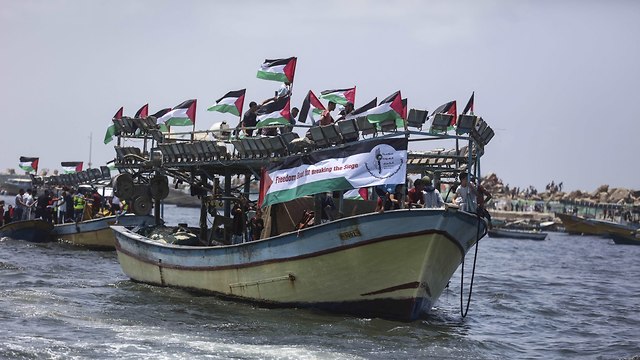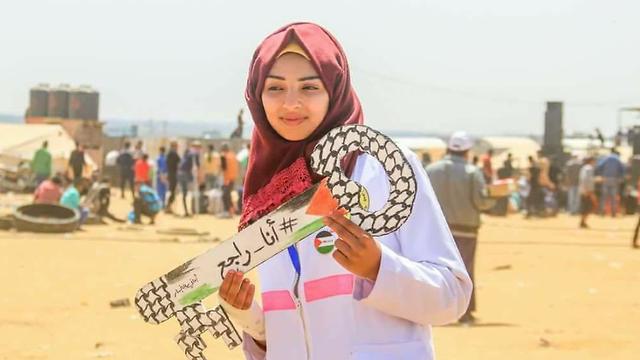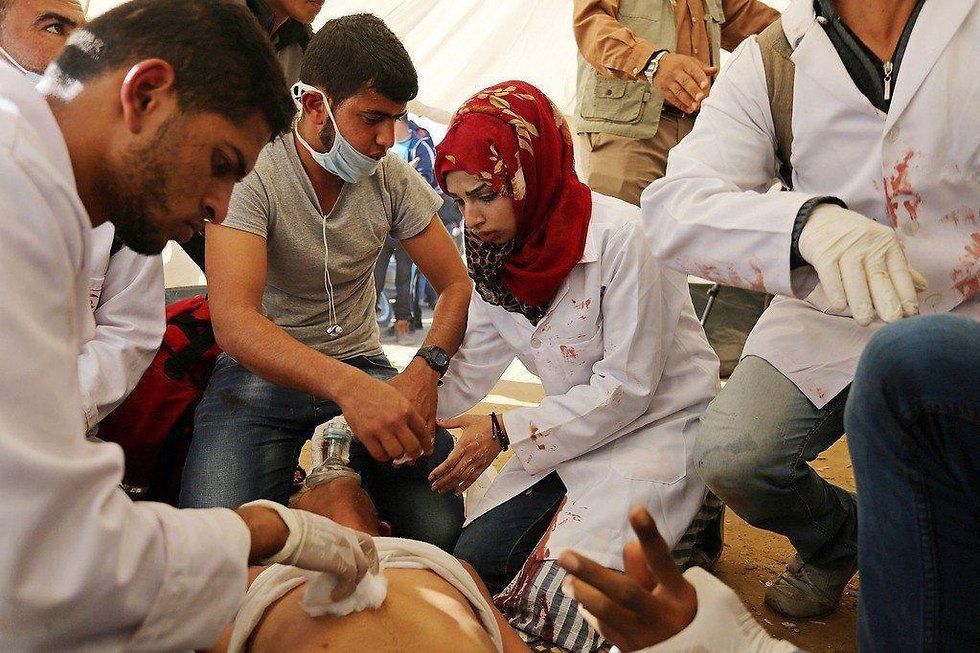

Palestinian woman killed by IDF fire in Gaza border clashes
PA news agency reports Razan Ashraf Najjar, 21, a volunteer paramedic, was killed while 'providing first aid to wounded' as March of Return protests resume near Gaza Strip border fence; 100 reported hurt, 40 from live fire; incendiary kites continue causing fires in Israel.
A Palestinian woman was killed from IDF fire near the Gaza Strip border as the weekly March of Return protest resumed Friday afternoon, just two days after the conclusion of the most recent conflagration between Israel and the Palestinian Gaza terror groups.
Razan Ashraf Najjar, 21, a volunteer paramedic, was shot as she ran toward the fortified border fence, east of the south Gaza city of Khan Yunis, in a bid to reach a casualty, a witness said.
Wearing a white uniform, "she raised her hands high in a clear way, but Israeli soldiers fired and she was hit in the chest," the witness, who requested anonymity, told Reuters.
At her house in Khan Younis, Najar's mother collapsed in grief as she was handed her daughter's blood-stained uniform.
A statement from Gaza's Health Ministry mourned Najar as a "martyr". Interviewed by Reuters interview in April, she said she would see the border protests through until their end.
"I am returning and not retreating," Najar's last Facebook post said. "Hit me with your bullets. I am not afraid."
She is the second woman killed in the March of Return protests.
The Palestinians also reported over 100 were wounded in the clashes, 40 of them from live fire.
According to the IDF, thousands of rioters were protesting on the Gaza border, hurling stones, burning tires and trying to sabotage security infrastructure. Israeli forces responded with crowd dispersal measures.
During the protests, an IDF vehicle came under gunfire. In addition, a suspect was spotted crossing the border fence in northern Gaza and putting down a grenade that went off as he was returning to the strip. There were no injuries among IDF soldiers.
Mahmoud Zahar, a Hamas official who joined the protest east of Gaza City, praised the turnout despite Ramadan.
"Those who bet on dwindling participation are proved to be wrong today," he told reporters.
This Friday's protests have been taglined "Friday from Gaza to Haifa"—marking not only the dream of Palestinian return but also the attempt to break through the naval blockade on the isolated enclave earlier this week.
In an effort to encourage protesters to arrive to the border area, Hamas used mosque loudspeakers to call on the public to head to the demonstration sites. Hamas also arranged transportation from all across the strip to the five return camps used as flashpoints for clashes with the IDF every Friday.
Meanwhile, Palestinians continued flying incendiary kites into Israel, causing fires in the Kibbutz Miflasim and Kibbutz Kissufim. No one was hurt, and firefighters were on the scene to battle the blazes.
On Thursday, incendiary kites caused fires in the Be'eri Forest, the Kissufim Forest and Kibbutz Ein HaShlosha, where damage was also caused to power lines.
Since the "terror kites attacks" have begun several weeks ago, 206 fires broke out in forests and groves alone.
Since May 14—which saw both the opening of the new US Embassy in Jerusalem and the apex of border protests—a significant downturn in the number of demonstrators has taken place, with only several thousand people participating overall since.
The beginning of the Muslim holy month of Ramadan shortly thereafter on May 17 only encumbered further the ruling terror group's efforts to bring out people en masse, due to the combined effects of the daytime fast and the heat.

Hamas's eyes now turn to Naksa Day next Tuesday, which commemorates the Palestinian defeat in the 1967 Six-Day War and Israel's taking of the West Bank, east Jerusalem and Gaza Strip.
Naksa Day, as per the original plans, was earmarked as one of the anticipated highlights of the protest campaign, but due to the recent round of hostilities, understandings reached with Hamas and talks on a long-term settlement with the terror group, the number and manner of protests on the day remained indeterminate.
The IDF's Southern Command has also estimated that Hamas will proceed with the border protests, especially on next week's Naksa Day.
"Operation Protective Edge's deterrence still resonates in the region, which is why Hamas has preferred marches of return over a (military) campaign and ordered to halt hostilities in under 24 hours," a senior Southern Command officer told reporters Wednesday.
"Hamas and Palestinian Islamic Jihad commanders went underground and disappeared this week," the officer continued. "Gaza is unstable and going through difficult times, with 140 people killed there in seven weeks—most of them terrorists."
"It is my estimate that Naksa Day will not have the same number of people as Nakba Day. There is a lot of internal criticism towards Hamas in the strip," he added. "the Islamic Jihad operated with Iranian assent this week, and Iran has an interest in escalating the Gaza situation in light of what's been happening in Syria and elsewhere."

















